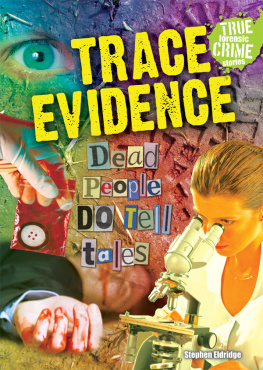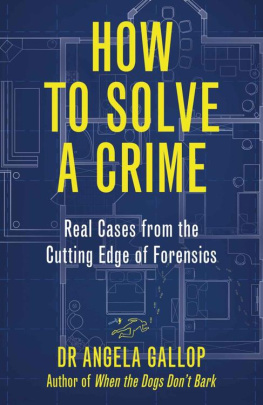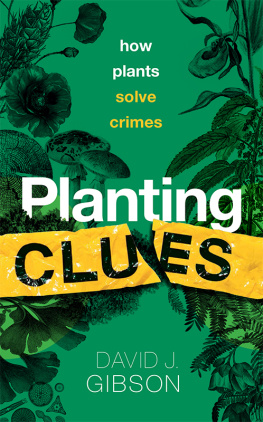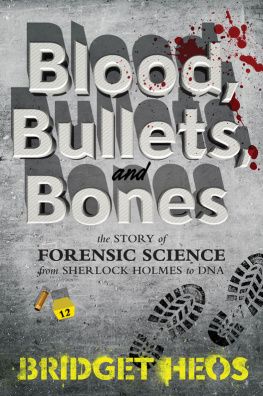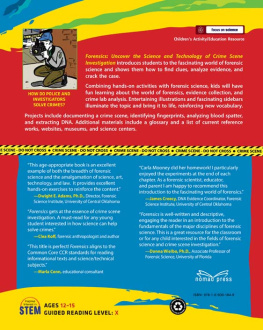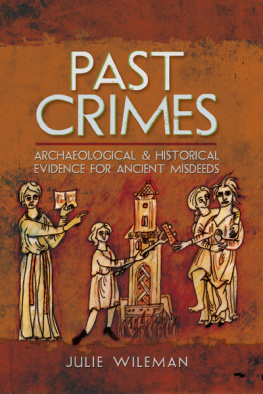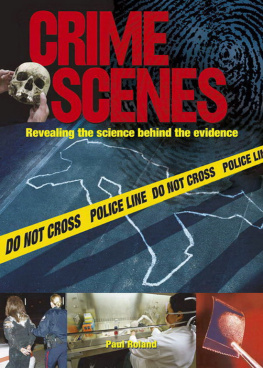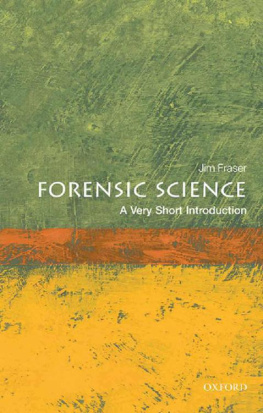EVERY CONTACT LEAVES A TRACE
Footprints Fingerprints Clothing Fibers Hair Wherever you go, you leave some evidence, or pick some up and take it with you. For this reason, detectives and forensic scientists have been using trace evidence to catch criminals for more than one hundred years. Find out how scientists collect and analyze evidence with these fascinating stories about how trace evidence helped solve crimes!
An insightful look into the world of trace evidence using real case examples. Readers will learn about the use of hairs and fibers to link criminals to their crimes, and how this evidence can be used in conjunction with DNA evidence.
Virginia M. Maxwell, D.Phil.
Associate Professor and Graduate Program Coordinator
Forensic Science Department
University of New Haven, West Haven, CT
About the Author
Stephen Eldridge is a writer and editor with a background in educational publishing. He lives in Chicago, Illinois, with his wife and fellow editor, Alison. This is his first published book.

Image Credit: Shutterstock.com
The fictional detective Sherlock Holmes solved crimes by examining evidence very carefully, sometimes with a magnifying glass.
I am glad of all details, whether they seem to you to be relevant or not. He studies a crime scene with a magnifying glass. He believes that every detail can tell him something about the crime and the criminal who committed it. Holmes has become famous because of his painstaking analysis of every detail of a crime.
Sherlock Holmes was a character in the stories of Sir Arthur Conan Doyle. Although he does not really exist, he is an inspiration for real detectives and investigators. In the first Sherlock Holmes story, Holmes discovers a body and a scrap of writing that contains a single mysterious word. Holmes solves the crime due to his amazing detective skills. However, Holmes himself once said, Life is infinitely stranger than anything which the mind of man could invent.
HANS GROSS WAS AN Austrian criminologist who lived around the same time that Sir Arthur Conan Doyle was writing about Sherlock Holmes. Gross was a professor who composed some of the first rules for how investigators should behave at a crime scene. Gross and Holmes had a similar approach to detection. Gross believed that the most important thing for an investigator was to observe absolute calm. The idea was to never move or in any way touch anything at the scene of a crime before it could be described or photographed for the record. In Grosss view, like Holmess, nothing is too small to be important to an investigation.
Unlike Sherlock Holmes, Eugne Franois Vidocq was a real detective. Despite this, Vidocq was almost certainly a stranger character than Holmes! As a young man in the late 1700s, Vidocq was a criminal. He was a thief and a deserter who had run away from the French army. When he grew older, though, he decided to turn his life around. First, he became a spy for the police. Eventually, he was made a police officer, even becoming the head of one of the first groups of police detectives in the world. Vidocqs methods sound like they come from movies or television, but they were real. He used disguises to infiltrate criminal organizations. He employed other former criminals, including some that worked for him in secret. He had an amazing memory that allowed him to easily recognize any criminal hed seen before. He even started his own detective agencymaybe the first in the world. He used tracessmall cluesat crime scenes to solve crimes, decades before Sir Arthur Conan Doyle first wrote about Sherlock Holmes.

Image Credit: Hulton Archive/Getty Images
The cover of a book about Eugne Franois Vidocq, a famous real-life detective
Suppose you are Eugne Franois Vidocq and it is the beginning of the nineteenth century. A man named Fontaine has been stabbed. He has twenty-eight wounds, and at first you believe he is dead. He is taken away to be examinedbut he is still alive. He is even able to tell you what happened to him. He was attacked by two men. The attackers stabbed him and robbed him. Fontaine fought back, and one of the men was hurt in the struggle. Despite the injury, the criminals got away. Fontaine does not know who the men who robbed him were, and no one else saw the crime.
How do you solve such a case? If you are Vidocq, you begin with trace evidence.
The case of Mr. Fontaine involves forensic science. Forensic science is the process of using clues and evidence to solve crimes. Because there are many kinds of clues, forensic scientists may use many different scientific fields (such as physics, chemistry, and biology) to help crack a case. Paul L. Kirk, an American forensic scientist, explained forensic analysis this way: Wherever [a criminal] steps, whatever he touches, whatever he leaves, even unconsciously, will serve as a silent witness against him. It is almost impossible for criminals to act without leaving a trace. Wherever people go, they may shed one of the millions of hairs on their bodies. They may mark anything they touch with fingerprints. They may leave footprints with every step. Forensic scientists find those tracescalled trace evidenceand use them to catch criminals.
Trace evidence can take almost any form. According to one trace analyst, Trace involves everything. And every case is different. Even if its two shoe print cases, theyre different. One might be in mud. The next one might be on a piece of paper. One might be in blood. Every case is different. Trace analysts have to be knowledgeable in many different fields of science. Physics can be used to find the path of a fallen drop of blood. Knowledge of chemistry can help identify a fiber. Biology can be used to identify the DNA in a drop of saliva. Every piece of evidence can help to catch a criminal, identify a victim, or reconstruct the events of a crime.

Image Credit: Shutterstock.com
Maybe the most famous kind of trace evidence is fingerprint evidence. Fingerprints are marks formed by the contact of the little ridges on a persons fingers with some other substance. Latent prints are fingerprints that are formed from the oils on a persons hand. These are usually invisible to the naked eye. Investigators use powders that stick to these prints so that they can be seen more easily.
What makes fingerprints so useful is that the little ridges on a persons fingers are unique. Even identical twins have different fingerprints! Fingerprints are so useful that many people have made careers studying them.
Early kinds of forensic science have been used since at least the eighth century. In the 700s, the Chinese used fingerprints to identify documents and sculptures. However, it was about a thousand years later that trace evidence began to develop as a way to solve crimes. In the eighteenth century, a man in England named John Toms was found guilty of murder in England because a piece of newspaper wadded in a pistol appeared to match a piece of paper found in his pocket. In 1835, Henry Goddard was working for Britains Scotland Yard. He became the first to use analysis of a bullet to catch a murderer when he noticed a visible flaw in the bullet.

